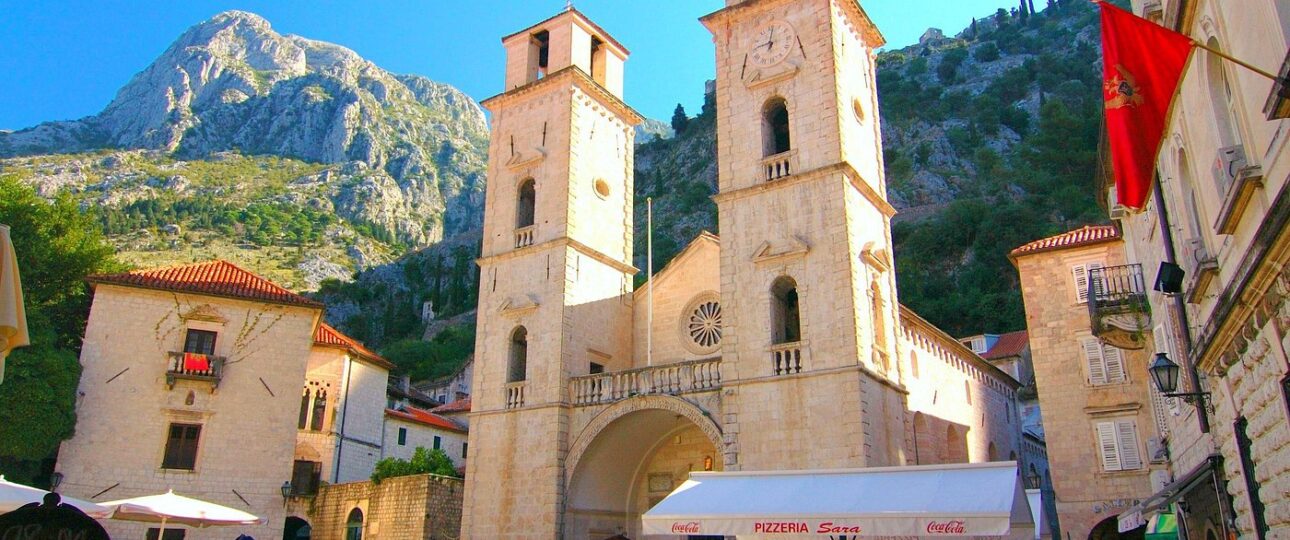Nestled deep within the stunning Bay of Kotor on Montenegro’s Adriatic coast, the ancient town of Kotor is a destination that captivates travelers with its dramatic landscapes, centuries-old history, and well-preserved medieval architecture. Surrounded by towering limestone cliffs and crystal-clear waters, Kotor is a UNESCO World Heritage Site that offers a blend of natural beauty, rich cultural heritage, and old-world charm.
Kotor’s history dates back over 2,000 years, with influences from the Romans, Byzantines, Venetians, and Austrians shaping the city’s unique identity. The town reached its peak during the Venetian period, which is still visible in the architecture, city walls, and urban layout. Walking through the maze of narrow, cobbled streets in Kotor’s Old Town is like stepping into a living museum. Gothic churches, baroque palaces, and ancient squares tell the story of a vibrant port city that once thrived on trade and naval power.
Key Attractions
- Kotor Old Town (Stari Grad): This walled medieval town is the heart of Kotor. Its landmarks include the Cathedral of Saint Tryphon (built in 1166), the Church of Saint Nicholas, and the Maritime Museum, which showcases the town’s seafaring tradition.
- City Walls and San Giovanni Fortress: Adventurous visitors can climb over 1,300 steps along the fortified walls up to the San Giovanni Fortress, which offers a panoramic view of Kotor Bay—a reward well worth the effort.
- Kotor Bay (Boka Kotorska): Often compared to a fjord, the bay is actually a ria (a submerged river canyon) and is known for its deep blue waters, steep mountains, and picturesque coastal villages like Perast and Risan.
Culture and Lifestyle
Despite its small size, Kotor is lively and culturally rich. Traditional festivals such as Kotor Carnival, Boka Night, and the International Summer Carnival attract both locals and tourists. The town also embraces a relaxed Mediterranean lifestyle, with plenty of outdoor cafes, seafood restaurants, and artisan shops.
A Growing Travel Destination
Over the past decade, Kotor has grown in popularity, particularly among cruise passengers and independent travelers seeking less-crowded alternatives to more famous Adriatic cities. While tourism has brought modern conveniences, Kotor has managed to maintain its authenticity and charm. Efforts to preserve its cultural and natural heritage continue to be a priority.
Getting There
Kotor is easily accessible by road from Montenegro’s capital Podgorica or from Dubrovnik in Croatia. The nearest airport is Tivat, just a short drive away. The scenic coastal drive to Kotor is considered one of the most beautiful in Europe.
Kotor is more than just a pretty postcard town—it’s a place where history, culture, and nature harmoniously coexist. Whether you’re climbing ancient fortresses, sailing through the bay, or simply enjoying a quiet coffee in a sunlit square, Kotor invites you to slow down and savor its timeless beauty.




Ищете подробную информацию коллекционеров? Эта платформа предоставляет всё необходимое погружения в тему монет !
Здесь доступны редкие монеты из разных эпох , а также драгоценные находки.
Изучите архив с характеристиками и высококачественными фото , чтобы найти раритет.
инвестиционные монеты
Для новичков или профессиональный коллекционер , наши обзоры и руководства помогут углубить экспертизу.
Воспользуйтесь шансом приобрести лимитированные монеты с сертификатами.
Станьте частью сообщества энтузиастов и будьте в курсе последних новостей в мире нумизматики.
**mindvault**
mindvault is a premium cognitive support formula created for adults 45+. It’s thoughtfully designed to help maintain clear thinking
**gl pro**
gl pro is a natural dietary supplement designed to promote balanced blood sugar levels and curb sugar cravings.
**sugarmute**
sugarmute is a science-guided nutritional supplement created to help maintain balanced blood sugar while supporting steady energy and mental clarity.
**vitta burn**
vitta burn is a liquid dietary supplement formulated to support healthy weight reduction by increasing metabolic rate, reducing hunger, and promoting fat loss.
**synaptigen**
synaptigen is a next-generation brain support supplement that blends natural nootropics, adaptogens
**glucore**
glucore is a nutritional supplement that is given to patients daily to assist in maintaining healthy blood sugar and metabolic rates.
**prodentim**
prodentim an advanced probiotic formulation designed to support exceptional oral hygiene while fortifying teeth and gums.
**nitric boost**
nitric boost is a dietary formula crafted to enhance vitality and promote overall well-being.
**sleeplean**
sleeplean is a US-trusted, naturally focused nighttime support formula that helps your body burn fat while you rest.
**mitolyn**
mitolyn a nature-inspired supplement crafted to elevate metabolic activity and support sustainable weight management.
**yusleep**
yusleep is a gentle, nano-enhanced nightly blend designed to help you drift off quickly, stay asleep longer, and wake feeling clear.
**breathe**
breathe is a plant-powered tincture crafted to promote lung performance and enhance your breathing quality.
**prostadine**
prostadine is a next-generation prostate support formula designed to help maintain, restore, and enhance optimal male prostate performance.
**pineal xt**
pinealxt is a revolutionary supplement that promotes proper pineal gland function and energy levels to support healthy body function.
**energeia**
energeia is the first and only recipe that targets the root cause of stubborn belly fat and Deadly visceral fat.
**prostabliss**
prostabliss is a carefully developed dietary formula aimed at nurturing prostate vitality and improving urinary comfort.
**boostaro**
boostaro is a specially crafted dietary supplement for men who want to elevate their overall health and vitality.
**potent stream**
potent stream is engineered to promote prostate well-being by counteracting the residue that can build up from hard-water minerals within the urinary tract.
**hepato burn**
hepato burn is a premium nutritional formula designed to enhance liver function, boost metabolism, and support natural fat breakdown.
**hepato burn**
hepato burn is a potent, plant-based formula created to promote optimal liver performance and naturally stimulate fat-burning mechanisms.
**flowforce max**
flowforce max delivers a forward-thinking, plant-focused way to support prostate health—while also helping maintain everyday energy, libido, and overall vitality.
**neurogenica**
neurogenica is a dietary supplement formulated to support nerve health and ease discomfort associated with neuropathy.
**cellufend**
cellufend is a natural supplement developed to support balanced blood sugar levels through a blend of botanical extracts and essential nutrients.
**prodentim**
prodentim is a forward-thinking oral wellness blend crafted to nurture and maintain a balanced mouth microbiome.
**revitag**
revitag is a daily skin-support formula created to promote a healthy complexion and visibly diminish the appearance of skin tags.
**memory lift**
memory lift is an innovative dietary formula designed to naturally nurture brain wellness and sharpen cognitive performance.
https://t.me/s/officials_pokerdom/3400
Interesting analysis! Seeing patterns in numbers is key, and platforms like jlboss seem to understand that excitement – offering diverse games. It’s about responsible fun & finding that ‘lucky’ feeling, right? Good insights here!